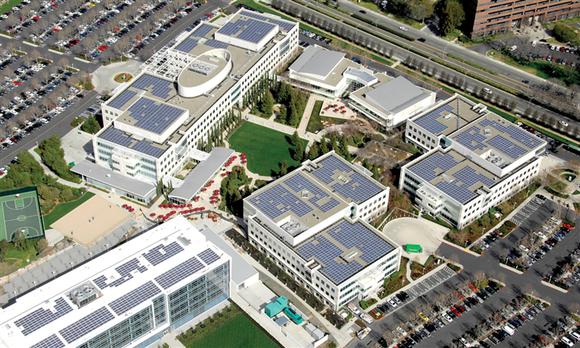
You’re running out the door for a date, and you’re late, and you’re maybe not looking quite how you want to look. Sure, you’d love to take a shower and put on brand-new clothes, but instead, you go the easy route: grab a clean shirt and head out the door. When large companies claim that they are going “100% renewable,” what they mean, in all but a few notable cases, is that they are going the easy route, purchasing wholesale energy from grid-scale sources such as wind or solar farms rather than local renewable energy sources.
Although the analogy is far from perfect, I’m going to be deliberately provocative and suggest that these companies’ actions are more like changing your shirt than changing the world. I admit I’m being unfair, so no need to accuse me of it! I recognize that it takes money and will to take this “easy route,” and that in fact, the real easy route is to do nothing. But grid versus microgrid renewable energy is an area I firmly believe requires education and understanding.
There are some great arguments in favor of utility-scale renewables. They can be a very efficient and effective mechanism for decreasing our overall carbon usage and footprint, and we need to make big changes fast, as fossil fuel use threatens our climate and way of life. Where there is a reliable grid, utility-scale solar and wind projects quickly and efficiently add renewables to the power mix.
But there are at least two important caveats to these systems and to claiming “100% Renewable.”
There is an upper limit to wind and solar on the grid
The power grid must maintain a nearly perfect balance of supply and demand. The grid benefits from its large scale – coal or gas-fired power plants can be quickly dispatched or turned off to keep the grid in balance. Solar and wind are “non-dispatchable” – they are at the whim of the resource, so when a cloud goes over a large solar farm, there is a large drop in supply. Again, as long as the grid is large and renewable resources make up a limited part of the supply, supply and demand balance out. It’s a rare day that every wind farm is still or every solar park or farm is under clouds. But there is a definite upper limit, and this limit is a huge technological challenge that has not been solved.
What this limit means for large companies that have the ability to source electricity is that as long as you’re first to the race, you can lay claim to the renewables. But we are all attached to the same wires.
Unless a company has its own solar panels, attached to its own property (see progress of Apple Campus 2 construction above), its effective renewable use is exactly the same as everyone else’s. Again, I’m not being completely fair. Companies that effectively apply pressure on utilities to include more renewables are making a difference. They are helping create mechanisms for investment in grid-scale wind and solar.
But here’s the reality. Even if every utility customer chose the “only sell me renewable energy” option with their utility, our grid-scale mix of renewables and non-renewables would not change in the short term, and there might actually be no way to deliver on the promise.
What about the 1.5 billion who live in energy poverty?
1.5 billion people have no access to electricity. In almost all these cases, the path to electricity is going to be through local generation. Although in many cases the local utility may prefer to extend its service to these areas, in reality these grids usually cannot even meet their existing loads. Extending a grid that already doesn’t work is some degree of the “definition of insanity,” i.e. doing the same thing over and over again and expecting different results. So distributed generation, usually with very high percentages of renewables, is really the only realistic mechanism for providing electricity. The potential impact on global productivity from electrification is almost beyond imagination. If 250 million women gained one productive hour each day because they have a little bit of electricity at the right time, it would be like gaining an entire productive UK workforce.
The RE100
The RE100 is a group of influential companies committed to “100% renewable power.” By taking this position, the group is making a statement, and a difference. RE100 launched at Climate Week NYC in 2014 with U.S. and European companies, is now expanding to India and China. These companies are demonstrating outstanding environmental responsibility by making this commitment. Google is on the list. According to https://www.google.com/green/energy/ – “…we see renewable energy as a business opportunity and continue to invest in accelerating its development. We believe that by helping power more of the world with renewable energy, we’re creating a better future for everyone.”
I simultaneously salute and challenge the RE100. I salute you for your leadership. I challenge you to do more. Some of you are in a position to change more than your shirt. Some of you are in a position to change the world. You can do this through any or all of the following actions:
- Use energy generated at your source. Use the roofs of your locations for solar panels. Back those up with storage, a benefit to all.
- As major utility customers, push to create policy and business models that support distributed generation. This can be a benefit to both utility and customer (i.e., your organization) if done well.
- Recognize that by playing a leadership role in distributed generation, you are leading the way to a future in which every human being on the planet has access to electricity. In this connected age, that’s a deal-changer.

eBay powers data center with corporate microgrid
The world really can get to 100% renewable energy. The energy will be a mix of grid-scale and distributed generation, but my bet’s on more and more distributed generation. The fastest path will combine the two well, taking advantage of the benefits of each. So go ahead and change your shirt. Then walk out the door determined to change the world.
